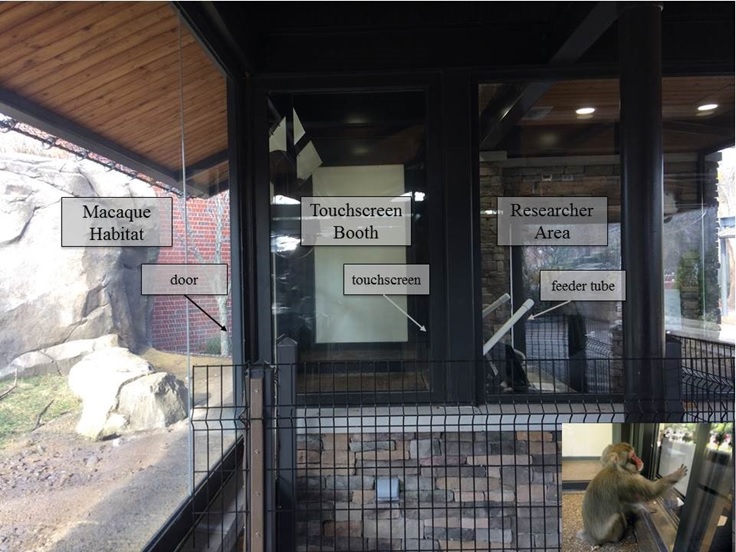
Using Touchscreens with Nonhuman Primates

For this quarter’s Hot Topics in primate welfare, ASP is featuring the use of touchscreens, a tool that opens new avenues for research and enrichment that can be used across settings and species. We interviewed three primatologists who use touchscreens as part of their research and welfare programs, including Dr. Chris Martin, Dr. Gill Vale, and Dr. Michele Mulholland.
Dr. Chris Martin (CM) is the Director of Research at The Indianapolis Zoo where, for the past decade, he has performed cognition work with orangutans and chimpanzees using touchscreen methods. He completed his doctoral work at Kyoto University Primate Research Institute under the supervision of Tetsuro Matsuzawa, where touchscreens were the primary method used in the chimpanzee cognition lab. In his career, he has designed, built, and completed cognitive studies with a variety of touchscreen systems and software tasks for primates, including interconnected and shared-screen systems for running tasks with multiple primates at once, single-subject systems that are embedded in walls at zoos, and all-in-one portable touchscreen/food dispenser systems that are battery powered and hang on mesh walls.
Dr. Gill Vale (GV), the assistant director at the Lester E. Fisher Center for the Study and Conservation of Apes in Chicago, has worked with nonhuman primates for almost 20 years. She began working with gibbons in zoological institutes located in the UK and Europe, and then extended her studies to chimpanzees, squirrel monkeys, rhesus monkeys, baboons, gorillas, Japanese macaques and humans. Her primary focus is on primate cultures, cumulative cultural evolution and the learning proclivities of primates, using puzzleboxes and manual tasks designed to mimic cognitive challenges primates face in the wild. At Lincoln Park Zoo, she oversees the touchscreen program to further knowledge of the primate mind, their preferences, perception, and emotions.
Dr. Michele Mulholland (MM), assistant professor at Michale E. Keeling Center for Comparative Medicine and Research (KCCMR) in Texas, has worked with nonhuman primates in a research capacity for 17 years, including marmosets, squirrel monkeys, rhesus monkeys, olive baboons, and chimpanzees. She began working on the touchscreen program at the KCCMR as a postdoctoral fellow with Dr. Hopkins several years ago as a way of collecting cognitive data from more animals in less time than traditional manual cognitive testing and examining age-related changes in cognition. Touchscreens had previously been implemented by Dr. Hopkins with the chimpanzees at the facility, so Dr. Mulholland worked to redesign the systems to be automated and expand to other species. Now as faculty, the systems are a major part of her research program, which is primarily focused on cognitive decline related to aging and disease.
With which species have you used touchscreens? Are there certain species that are particularly adept at using touchscreens?
CM: I’ve used touchscreens with Chimpanzees, Orangutans, and several macaque species over the past two decades. In each of these cases there were individuals that were adept and motivated and others that were less interested in the tasks. How much a given primate is motivated by food rewards usually determines whether they fall into one category or the other. As far as comparing performance on touchscreen tasks across species, this is something I’m looking forward to examining in the future with the eleven orangutans and the newly-arrived twenty-one chimpanzees where I work at The Indianapolis Zoo.
GV: My current program at the Lester E. Fisher Center for the Study and Conservation of Apes at Lincoln Park Zoo presents touchscreens to resident gorillas, chimpanzees and Japanese macaques. My expectation was chimpanzees would excel in touchscreen tasks and that Japanese macaques would be tricky to work with due to their despotic social structure. Contrary to this, the Japanese macaques, so far, appear to learn tasks quicker than the apes and may pay closer attention to touchscreen tasks. However, we have different testing set-ups for the apes and monkeys which may explain species differences. The tasks we present and participant ages may also play a role.
MM: We have chimpanzees, rhesus monkeys, and squirrel monkeys (two species) that have been using touchscreen systems for several years, and we are in the process of installing systems for our olive baboons (though we have already done short touchscreen testing sessions with them). So far, we have not had any difficulty getting any of these species to utilize the touchscreens, as all species are highly motivated to use them and produce a high number of trials daily. There are, of course, individual differences in usage, but overall, we have had no species that we find more difficult to work with than others.
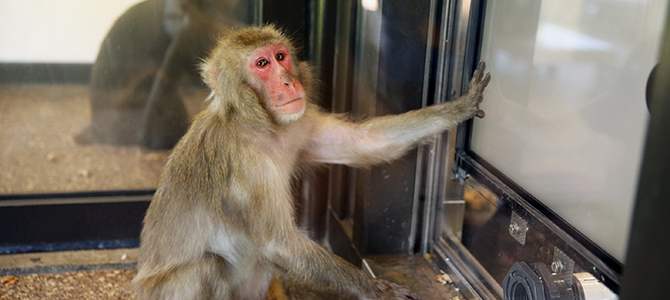
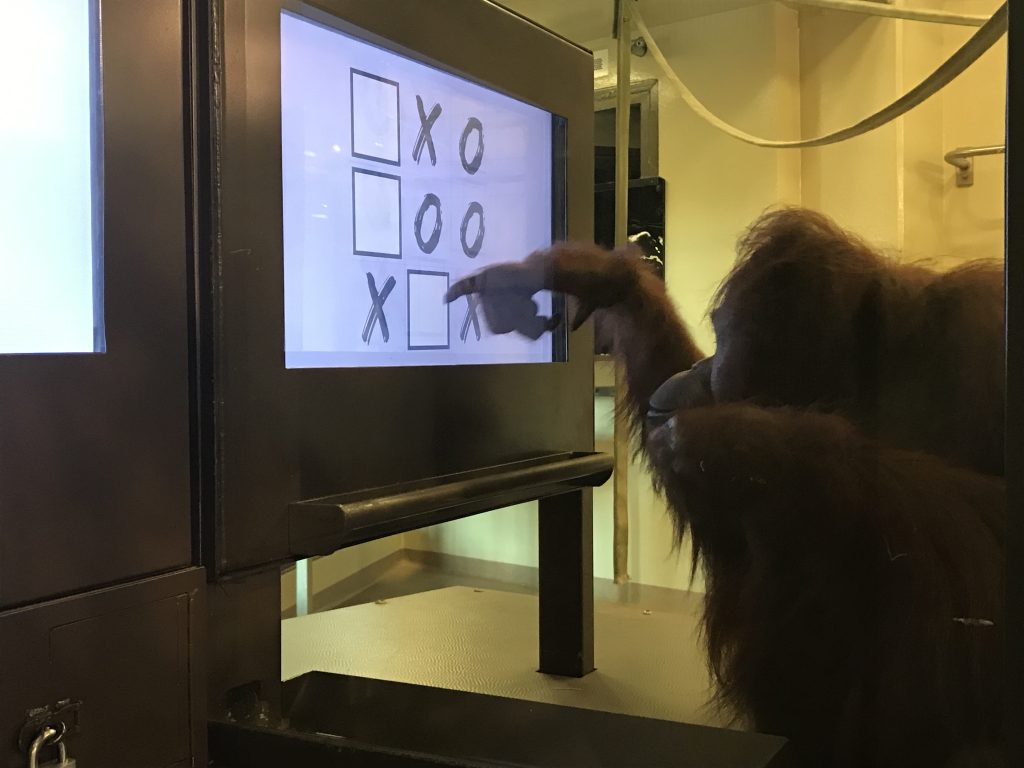
What kinds of tasks are used with touchscreens?
CM: Working in a zoo setting, I try to create tasks that are immediately recognizable by zoo visitors while also being useful for research and enrichment purposes. A good example is the “Matching Pairs Game”, also known as “Concentration” and “Memory”. Everyone recognizes this game right away, so it’s a great way for folks to learn about the intellectual capabilities of the apes they are watching. From a research perspective, it’s a nice task to examine visuospatial memory and strategic reasoning.
I also make primate tasks that promote enrichment and husbandry. For example, I have a slideshow application that enables primates to look at photos from categories of their choosing, and husbandry tasks that allow care staff to upload photos of food or enrichment items and then give the primates the option to choose between them.
GV: We use a number of modules, including forced-choice tasks that enable us to assess primates’ preferences for items (e.g., preferred and unpreferred foods), match-to-sample and sequencing tasks that provide insights into NHPs learning and memory abilities, and attention tasks that help us investigate what captures NHPs attention and whether they differentiate between certain stimuli. We also look at individual differences and how that may impact cognitive performance. Additionally, our center has a history of using touchscreen tasks to assess the effects of noise and zoo visitors on cognition.
MM: We have social cognition, concept learning, discrimination learning, executive function, memory (spatial and nonspatial), inhibitory control, and motor tasks that we implement with our touchscreen (or joystick) systems. There are endless possibilities.
What are the goals of your touchscreen work?
CM: I have three goals: 1) provide an enriching activity for primates, challenging them to exercise their minds to earn food rewards, 2) demonstrate to zoo guests the intelligence of primates in order to direct attention toward conservation issues, and 3) gain and share new insights into how primates think and perceive the world.
GV: We have four main goals. The first is cognitive enrichment. The second is to promote understanding of primates: how they think, feel, and what they prefer. These help us with the third goal of promoting enhanced welfare of primates. The fourth is to promote and foster interest in primates and primate conservation through public engagement. Most of our touchscreen testing is public-facing and interpreted to guests to garner interest, awareness and understanding of primates.
MM: I am interested in age-related cognitive decline as well as cognitive impairments related to disease and disease treatment. One goal is to characterize the baseline cognitive abilities of primates across all ages so that we can learn more about, and eventually prevent, cognitive impairments.
What challenges have you faced in your touchscreen work and how have you mitigated those challenges?
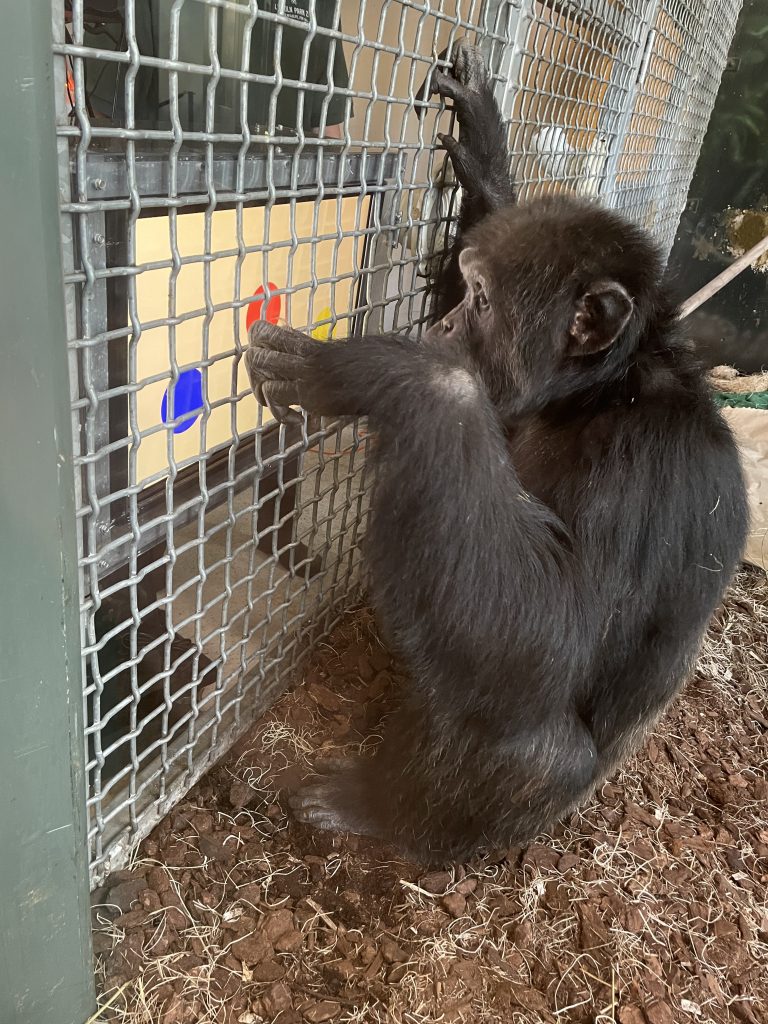
CM: For hardware design, the biggest challenge is making equipment that is ape-proof. Orangutans in particular are good at breaking things in a methodical and persistent manner, so new touchscreen system designs usually require multiple iterations. At first, I would get disheartened when they broke my equipment and I knew I’d have to rebuild it to patch the weakness they exploited, but over time, I grew to appreciate what good beta-testers they are. Now, I embrace it when they can break something.
For software design, I think the biggest challenge in designing any primate research task is keeping it simple enough for them to comprehend and stay motivated while also making it difficult and complex enough to generate the nuances of their species-typical behavior. It’s a fine line to walk. Computerized methods can be helpful in this regard because of the programmability and variety of tasks, and they can capture response latency at a millisecond scale, which provides an informative measure to supplement performance rates.
GV: One of the challenges is testing in a group setting. Group settings are beneficial for many research endeavors as they avoid individual separations and subsequent re-introductions, while providing more naturalistic contexts with enhanced ecological validity for group living primates. The cost is competition over a limited resource and the potential for aggression. To mitigate this challenge, one can present multiple touchscreens simultaneously, which helps to alleviate resource competition. This is the approach we use for the macaques. They have two parallel test booths, each containing a touchscreen. We also cease sessions when more than one monkey enters a booth. This helps discourage multiple individuals participating concurrently. Sessions then resume once only one monkey remains in the booth. While conspecific interruptions happen, this procedure and set-up, along with “end screens” – individualized colored pictures that indicate a monkey’s session is over – mean we usually collect data from the majority of the group on a daily basis. For apes, we employ a slightly different set-up of one touchscreen atop a mobile cart. For them, we simply move the cart and touchscreen out-of-reach upon conspecific disruptions. In addition to the physical set-up, it is also important to know the social dynamics of groups to help researchers identify a pattern or order of participation that reduces any risk for potential competition.
MM: Each species has their own unique challenges in the implementation of the systems. We have learned a lot about how to modify our hardware and software for each species. For example, we found that our squirrel monkeys initially grouped around a single system, and several would try using it at once (while another hung upside down to try to drink the reward!). We very quickly modified the set up so that there was a small mesh “booth” in front of each system to limit access to a single individual at a time. The groups with which you first implement your touchscreen systems will very quickly find any flaws in the design, installation, and programming, so it’s important to observe those groups closely to learn what changes need to be made.
What reinforcers do you use during touchscreen tasks?
CM: I use a combination of breakfast cereal, primate precision pellets, and fresh fruit as primary reinforcement. For secondary reinforcement, I always use the same chime and buzzer sounds so that there is consistency across tasks to help facilitate learning and comprehension.
GV: The rewards we regularly use are a medium or medium-low value food (e.g., blueberries for apes and carrots for monkeys) while ensuring the foods are motivating for each individual. This ties into the above question as we can discourage any competition that could otherwise arise over high-value food. However, food reinforcers also change depending upon the task. An example is the food preference re-assessments we recently conducted, where primates were provisioned the foods that matched those selected in their pictorial form (preferred and unpreferred) (Vale et al., 2024). We also usually include secondary sound reinforcers that indicate whether a response is “correct” or “incorrect”.
Reference: Vale GL, Leinwand JG, Joshi PB. Testing three primate species’ attentional biases toward preferred and unpreferred foods: Seeing red or high valued food? J Comp Psychol. 2024 Feb 29. doi: 10.1037/com0000375. Epub ahead of print. PMID: 38421739.
MM: For our squirrel monkeys, we use a couple drops of a liquid reward (currently Thirster™ but we’ve used others successfully). Our rhesus, baboons, and chimps receive a single fruit flavored pellet (Primate Dustless Precision Pellets from Bio-Serv; 190 mg for rhesus and baboons, and 1 g for chimpanzees) along with both audio and visual cues when they select a correct response.
What advice would you give someone who wants to begin using touchscreens at their facility? Please address: 1) Cost range per unit, 2) How does one go about obtaining a touchscreen?, and 3) What kinds of modifications to living areas or enclosures may be needed to accommodate touchscreens?
CM: My advice is to not be intimidated by the technological hurdles and costs. The payoff is worth it because your primates will enjoy the dynamism of computer tasks and the ability to work for food rewards! Also, while in the past touchscreen adoption meant having to learn niche skills like programming and building your own custom touchscreen/computer/feeder combo, currently, there are some plug-and-play solutions. This is where I’ll shamelessly mention my all-in-one primate touchscreen system (Apex), and software suite (ApeTouch), which I offer through my website Zenrichment.com. As far as modifications go, the best of all worlds is an open access screen that doesn’t have mesh between the screen and the primate.

GV: Costs can vary. The touchscreens we use are approximately $270. Additionally, a computer is required to run the tasks, and some form of platform or cart is required. Screens typically need to be protected, especially with larger primates, to prevent damage. Another consideration are the tasks themselves, which need to be programmed or purchased (e.g., ApeTouch, Martin et al., 2022).
Enclosure modifications range from few, if any, to the creation of specially designed test booths. When facilities have mesh panels or safe areas through which the participant can reach the touchscreens, while protecting the researcher, if present, few modifications can be required. Specialized, permanent booths designed solely for touchscreens require advanced planning and entail more extensive modifications to primate’s enclosures.
MM: All of our systems are custom- built and programmed at our facility. The current cost for a fully functioning system is between $2300-2900. We found that this was more cost effective than purchasing commercially available systems. This also gives us flexibility in terms of the types of food rewards that we can use, tasks we want to program, new features we want to add, etc. Since we build our own testing systems, we purchase all the components needed from various vendors. We are happy to share our part list and help others to build systems like ours. We have built systems and sent them to collaborators and have also sent parts lists and construction advice to others. If anyone is interested, they can reach out via email. We are currently working on putting together a user manual and fabrication guide for our systems that we can share with others. We are also hoping to host workshops in the future.
So far, we have not needed to make modifications to the enclosures themselves other than mounting our systems on the outside of the enclosure and perches on the inside. The openings in the walls of our enclosures are wide enough to allow the monkeys to reach the screens (or joysticks) without any issues. If enclosures have openings that are too small to reach through, then a modification to the opening to allow better reach, while also not compromising the safety of the animals or integrity of the enclosure, may be needed. We have new buildings under construction now and were very lucky to be able to incorporate the systems into the enclosure design. These new enclosures have a system port specifically made for our touchscreen systems, without any bars or mesh in front of the screen and include a lockable sliding door to protect the system when the enclosure is being cleaned. One important modification when adding touchscreens to existing facilities, especially outdoor housing, is the addition of electrical outlets. Obviously, you need to power the systems and most enclosures may not have nearby outlets (or enough outlets). This requires working closely with facilities management to determine how to get power to the systems in a safe manner. Our facilities team has been phenomenal regarding our electrical needs. They have run conduit and electrical to fully outdoor enclosures and have installed outlets in the ceilings of our sheltered enclosures so that we have adequate power for all our systems. They have also installed larger waterproof covers on existing indoor and outdoor outlets so that our systems can remain plugged in but are protected from hose spray or adverse weather.
In what ways do you think touchscreen work enhances primate welfare in captivity? Do you have data that demonstrates that nonhuman primates like or prefer to use touchscreens?
CM: There is growing evidence that many zoo-housed species, including primates, prefer to work for food rewards rather than have food handed to them, which is a phenomenon known as contrafreeloading. Touchscreen tasks can amplify the benefits of contrafreeloading to promote welfare in some interesting ways. Not only do they offer an opportunity to work for food, but they can also be programmed to target mental skills that primates in the wild are likely to rely on, such as memory and spatial reasoning. This makes touchscreens not just enriching but also functionally naturalistic.
GV: Touchscreens present cognitively challenging and engaging problems that are intellectually stimulating for them. Touchscreens provide additional agency, choice, and control over another feature in their environment. The research itself also enhances primate welfare as we learn more about individuals and species in human care. Touchscreen tasks can be designed to reveal and track changes in animal wellbeing, mood, and emotions, and/or to tailor enrichment items, foods, and features of their habitat according to identified needs and preferences. This is all information helps guide management decisions and husbandry practices. For facilities with guests, such as zoos, touchscreens can also help elucidate primates’ responses to anthropogenic noise and crowding. At Lincoln Park Zoo, we monitor participation levels to explore which individuals choose to participate in the program. The high levels that we observe suggest that touchscreens are intrinsically (or extrinsically, given we provision food rewards) motivating. Overall, touchscreens offer a research avenue that can help improve (i) husbandry practices, (ii) the resources or in-puts provided, (iii) welfare assessments, (iv) cognitive enrichment, and lastly, (v) our understanding of primate cognition and their preferences.
MM: As we know, nonhuman primates have cognitively rich natural environments requiring individuals to remember various food sources, navigate complex social relationships, avoid predators, etc. Touchscreen systems can provide cognitive enrichment in the captive environment. The use of our systems is completely voluntary and at the individual’s own pace, giving them more choice and control over how they spend their time. Importantly, we have started to utilize our systems to identify potential clinical issues prior to observable symptoms. We track usage of the systems and performance on the tasks, and alert clinical staff if there is a sudden, unexplainable change in either usage or performance so that they can keep a closer eye on those individuals. This exchange goes in the opposite direction as well. After identifying an animal with clinical symptoms, our veterinary team has asked us about that individual’s system use and performance. We have shown reduced system usage and performance leading up to dental issues, heart failure, cancer, and other health issues. In the future, we hope to develop an automated alert that can go out to PIs, veterinarians, and clinical staff based on data from our systems.
Can touchscreens be used with group-housed animals?
CM: Yes! I recently did a study along these lines with Akiho Muramatsu at Japan Monkey Centre. We hung a portable touchscreen apparatus on enclosures of several different macaque species and examined their social styles in response to the touchscreen. For the despotic species like Pig Tailed and Japanese Macaques, a dominant individual monopolized the screen. For the more egalitarian species like Bonnet and Tibetan Macaques, the screen was shared by multiple individuals each session. The utilization of the touchscreen followed the manner of their natural species-typical social styles. There is an interesting point to be made about cases where a dominant individual monopolizes the touchscreen. If this happens, the subordinate groupmates may still benefit indirectly from the presence of the screen because they get to have time outside of the watchful gaze of the dominant individual who is distracted by the touchscreen.
GV: Absolutely, with the caveat that each group is different, and social tolerance varies across individuals and species. At the zoo, we test four of five of the groups in their intact social groups. The exception is the bachelor gorillas that we test in their separate “bedrooms” each morning before they regroup in their habitat for the day for husbandry/management purposes. It takes some time for individuals to learn to “take turns”, but, through team effort and the long-term persistence of past and present staff, we are now consistently testing in group-housed primates. Doing so ensures that our program is truly voluntary: if an individual doesn’t want to participate, they simply opt out.
MM: Absolutely. All of our systems are currently implemented with social groups. To do so, you need a way to identify the individual using the system so that you can keep track of their data. This can be done in many ways. Some facilities have a researcher who initiates or observes testing sessions and records who is using the system. At our facility, all squirrel monkeys, rhesus monkeys, or baboons within a group are microchipped in each wrist, and they reach through an RFID reader to touch the screen. This allows us to record who is working and when. The KCCMR investigators and our collaborators are also working to develop facial recognition software that can identify who is using the system. Another collaborator is also currently working on inserting microchips into the ID tags that their monkeys already wear, and others in the past have trained individuals in the group to first touch their assigned icon on the screen before they work. It is also important to provide multiple systems for larger groups to reduce competition. For example, at our facility, we generally provide 1-2 systems for smaller groups of around 8 individuals, and 4-6 systems for larger groups (but this depends on species and enclosure type as well). We also provide access to ACTS for long periods of time, 12-24 hours per day, which greatly improves access for more subordinate individuals in the groups.
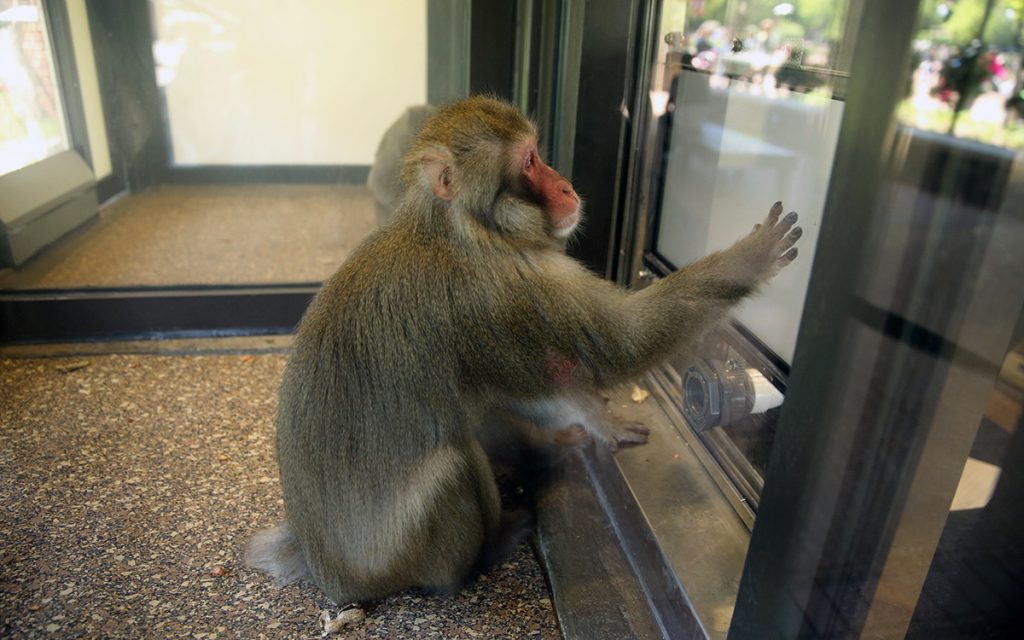

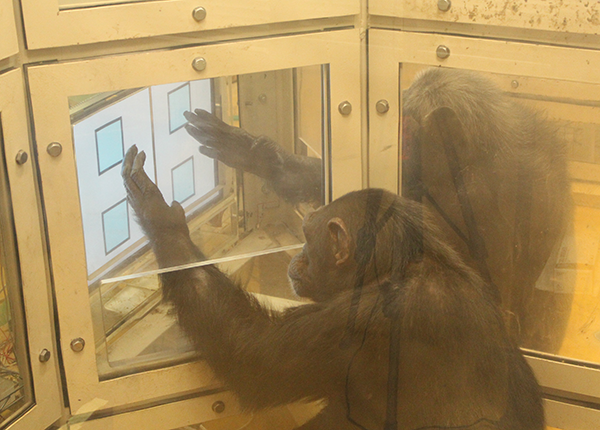
What kinds of future directions would you like to see with primate use of touchscreens?
CM: Something I’m focused on for the future is not just the touchscreen tasks themselves but the context in which the touchscreens get used. I’d like to see how installing multiple touchscreens throughout an enclosure might contribute to more naturalistic foraging and social grouping behaviors. At Indianapolis Zoo, we are currently finishing construction on a new exhibit that will house a large group of up to 30 chimpanzees. The exhibit consists of multiple yards and buildings spread around the Zoo and connected by a quarter mile of overhead travel corridors, so the chimpanzees can decide where they want to go and with whom they want to spend their time. We plan to install at least ten touchscreen stations at different locations around the exhibit, and we will test how the touchscreen locations and the schedule of their activation impacts the chimpanzees’ movement and fission-fusion ranging patterns.
GV: There are many avenues for future research. One question research groups ask is what types of tasks or challenges primates preferentially choose to engage in. Are some tasks preferred over others and at what level of difficulty? This information can enhance the enrichment value of touchscreen programs through a multiple-choice approach. Another interesting question is whether touchscreen tasks are inherently rewarding (i.e., contra-freeloading, as mentioned earlier by CM). Previous studies also highlight the utility of touchscreens in assessing primates’ emotions and welfare. There is still much to explore in these and other areas, including in my research area of primate cultures, cultural learning, and complexity.
MM: I would like to see more harmonization of the systems and programs used across species and facilities, so that we can more easily compare results across studies and potentially combine data from multiple facilities into larger datasets. I also would like to see broader application of touchscreen systems, not just as an excellent research tool, but to provide more cognitively stimulating environments for captive populations and as a tool that veterinary teams can use identify health issues earlier.
